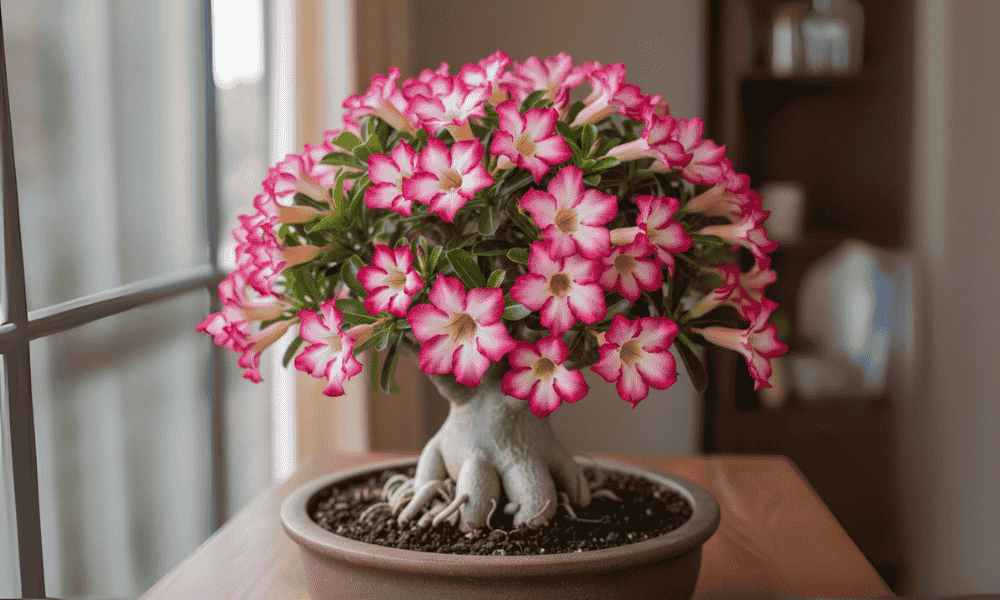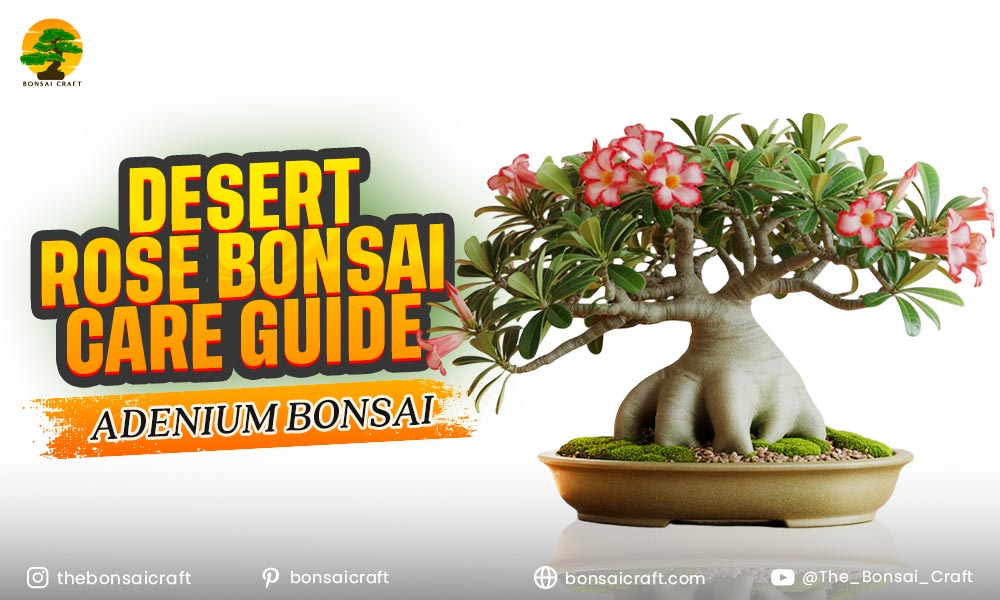
The Desert Rose Bonsai is a captivating miniature tree that combines exotic beauty with rewarding horticultural practice. Known scientifically as Adenium obesum bonsai, this succulent bonsai displays striking, trumpet-shaped flowers and a thick, caudiciform trunk that stores water, making it highly resilient in arid conditions. Whether you are an experienced bonsai enthusiast or just beginning your journey, learning how to bonsai desert rose offers both creative expression and practical gardening skills.
With years of study and hands-on experience, I have found that cultivating a desert rose bonsai requires patience, attention to detail, and an understanding of its unique growing conditions. From choosing the right soil to mastering pruning techniques, each step contributes to a thriving bonsai that can blossom year after year. This guide provides a comprehensive, timeless reference for desert rose bonsai care, ensuring that your miniature Adenium remains healthy, vibrant, and aesthetically pleasing for decades.
By following this guide, you’ll gain practical knowledge on how to care for desert rose bonsai, select the best soil for desert rose bonsai, prune your Adenium for optimal shape, and enjoy the meditative process of bonsai creation.
The desert rose bonsai stands out due to its swollen caudex, vibrant trumpet-shaped flowers, and glossy green leaves. Unlike traditional bonsai trees, Adenium bonsai thrives in arid conditions, requiring bright light, well-draining soil, and precise pruning to maintain its miniature beauty.
Desert rose bonsai is native to semi-arid regions of Africa and the Arabian Peninsula. Its thickened trunk, or caudex, serves as a water reservoir, allowing the plant to withstand dry conditions. The tree produces seasonal flowers in shades of red, pink, white, and even bi-color varieties, creating a visual spectacle that draws attention.
Its slow growth, combined with unique structural characteristics, makes adenium bonsai ideal for bonsai enthusiasts seeking both artistry and horticultural challenge. With proper care, a miniature desert rose can thrive indoors or outdoors, becoming a living work of art that develops over the years.
How Long Does It Take to Grow a Desert Rose Bonsai?
A desert rose bonsai can reach a beginner’s shaping stage within 2–3 years, while a fully mature bonsai with a well-defined caudex and flowers typically takes 5–7 years. Growth speed depends on light, soil quality, watering, and pruning consistency.
Starting a desert rose bonsai from seed requires patience. Seeds germinate in 1–3 weeks under optimal conditions, but shaping the trunk and branches takes time. Using nursery-grown saplings can reduce initial development time.
Regular pruning, careful wiring, and seasonal fertilization accelerate growth, but the process remains slow compared to other bonsai species. This deliberate growth pace is what allows bonsai enthusiasts to create balanced, artistic forms while maintaining plant health.
How to Grow Desert Rose Bonsai from Seed or Sapling
To grow a desert rose bonsai, soak seeds for 24 hours before planting in a well-draining bonsai soil mix. Keep seedlings in warm, bright conditions and gradually transplant to bonsai pots. For saplings, select healthy plants and begin shaping immediately with pruning and wiring.
Step-by-Step Guide:
- Seed Preparation: Soak seeds in lukewarm water for 24 hours to soften the seed coat.
- Planting Medium: Use a mix of cactus soil, pumice, and organic compost for excellent drainage.
- Germination Conditions: Maintain 75–85°F (24–29°C) with bright indirect sunlight. Keep soil lightly moist.
- Transplanting: When seedlings reach 3–4 inches, transfer them to shallow bonsai pots with well-draining soil.
- Early Training: Begin light pruning to encourage branching and define the caudex shape after the first year.
Starting from seed offers control over trunk shape, branch placement, and overall bonsai structure.
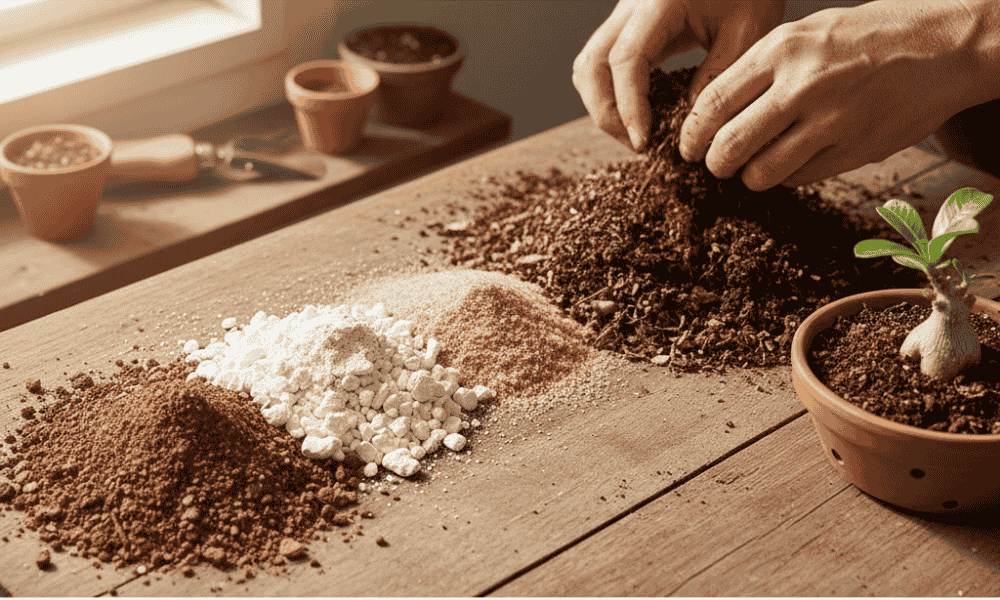
Best Soil for Desert Rose Bonsai
Desert rose bonsai soil must be well-draining to prevent root rot. A mix of cactus soil, pumice, sand, and organic compost ensures moisture retention without waterlogging, supporting healthy root and caudex development.
Adenium bonsai is highly sensitive to excess water. Therefore, choose soil that allows rapid drainage while maintaining enough moisture for growth. A common desert rose bonsai soil blend includes:
- 50% coarse sand or pumice
- 25% cactus potting mix
- 25% organic compost
Repotting every 2–3 years refreshes soil, prunes roots, and ensures optimal nutrient uptake.
Light, Watering, and Temperature Requirements
Desert rose bonsai care requires 6–8 hours of sunlight daily, careful watering to keep soil moist but not soggy, and protection from frost. Ideal temperatures are 65–85°F (18–29°C).
- Light: Full sun promotes flowering and strengthens the caudex. Indoors, place near a south-facing window or use grow lights.
- Watering: Allow the soil to dry slightly between waterings. Overwatering causes root rot; underwatering can stress the plant but is less damaging.
- Temperature: Protect Adenium bonsai from frost. If grown outdoors in temperate climates, move to a sheltered location during winter.
How to Prune Adenium for Bonsai
Prune desert rose bonsai by cutting back new shoots to 2–3 pairs of leaves and removing weak or crossing branches. Regular pruning maintains shape, encourages branching, and enhances flowering.
Pruning is essential to define the bonsai desert rose structure and maintain aesthetics:
- Maintenance Pruning: Trim soft shoots regularly to control size and encourage new branches.
- Structural Pruning: Cut larger branches during the growing season to shape the trunk and canopy.
- Flowering Management: Light pruning after flowering stimulates new growth and future blooms.
- Tools: Use sharp bonsai shears to prevent damage to delicate branches.
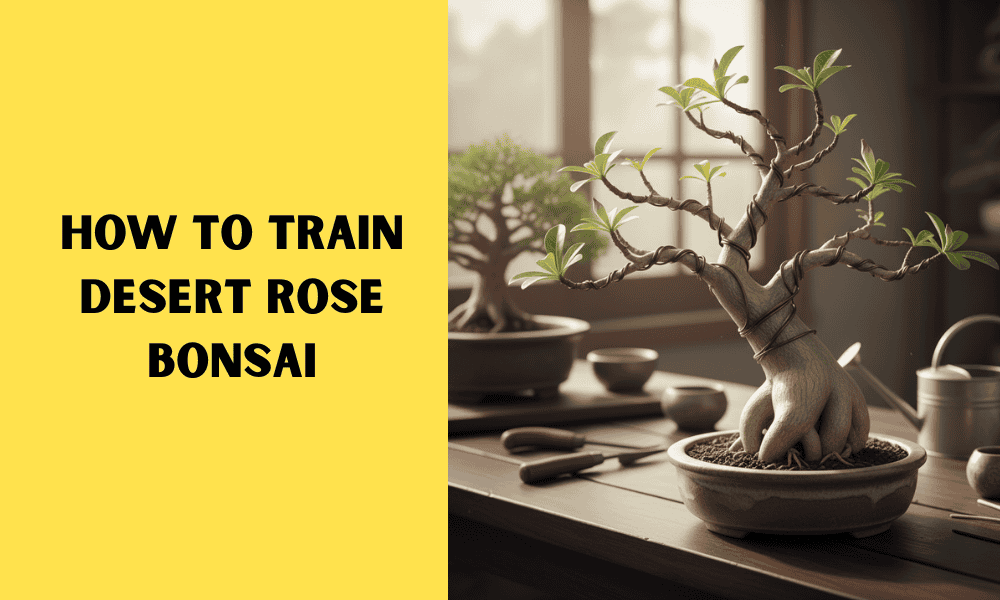
How to Train Desert Rose Bonsai
Training a desert rose bonsai involves careful wiring, shaping the trunk gradually, and managing branch development. Start early, apply gentle bends over time, and respect natural growth patterns for long-lasting bonsai artistry.
Training Techniques:
- Wiring: Wrap young branches with soft aluminum wire to bend into desired positions.
- Trunk Development: Allow selective branch growth to thicken the caudex, then prune excess.
- Styling Forms: Suitable for informal upright, slanting, or cascade styles.
- Patience: Gradual training avoids branch breakage and ensures natural, elegant shapes.
Common Challenges in Desert Rose Bonsai Care
Challenges include leaf drop, pest infestations, overwatering, and frost sensitivity. Consistent monitoring, proper watering, and seasonal pruning mitigate most problems, ensuring a healthy adenium bonsai.
- Leaf Drop: Often caused by overwatering, temperature fluctuations, or stress.
- Pests: Monitor for aphids, mealybugs, and spider mites. Use gentle insecticidal soap if needed.
- Overgrowth: Fast-growing branches require routine pruning to maintain compact form.
- Frost Sensitivity: Protect from cold temperatures; move indoors or use frost covers.
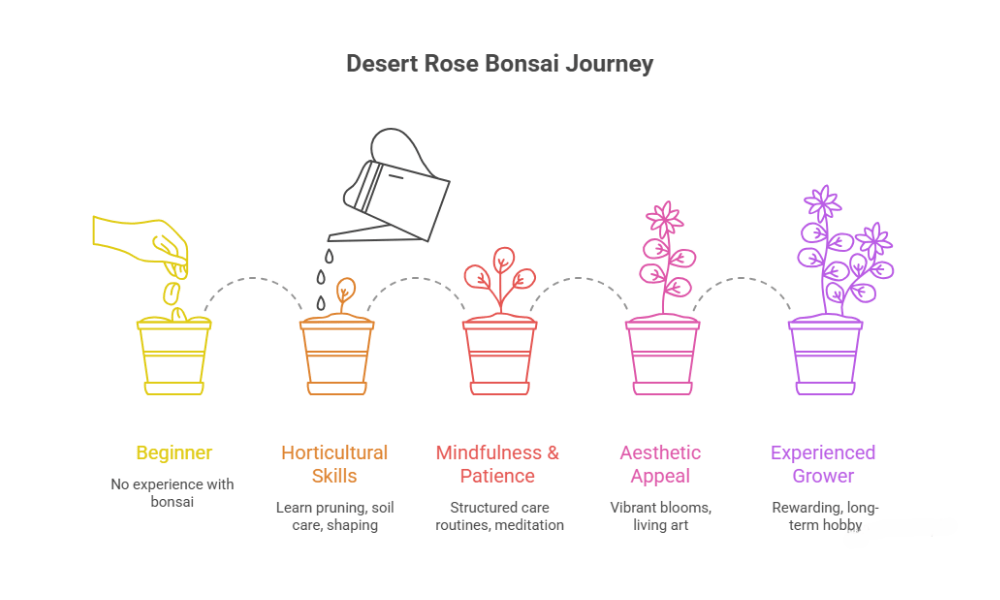
Benefits of Growing Desert Rose Bonsai
Growing a desert rose bonsai enhances mindfulness, relieves stress, and provides a unique aesthetic appeal. It develops horticultural skills in pruning, soil care, and creative tree shaping, offering a long-term rewarding hobby.
- Adds vibrant color to your home or garden with exotic blooms.
- Develops patience and attention to detail through structured care routines.
- Offers a meditative gardening experience, promoting relaxation and creativity.
- Creates a living piece of art that evolves over the years, increasing personal satisfaction.
Conclusion
Caring for a desert rose bonsai is both an art and a science. From growing your adenium bonsai from seed to shaping the trunk, pruning, and flowering management, each step enhances your understanding of bonsai cultivation. This miniature tree rewards dedication with spectacular flowers, a unique caudex, and a sense of accomplishment that few other plants can provide.
Expert Tip: Observe your bonsai closely every season, adjust care practices based on plant response, and maintain patience. With consistent attention, your desert rose bonsai will thrive for decades, becoming a centerpiece of beauty, artistry, and personal joy.
FAQs
Can you bonsai a desert rose?
Yes, a desert rose bonsai thrives in containers, responds well to pruning and wiring, and produces vibrant trumpet-shaped flowers, making it an excellent candidate for bonsai cultivation.
How long does it take to grow a desert rose bonsai?
Shaping a bonsai begins in 2–3 years, while full caudex development and flowering maturity can take 5–7 years. Patience and consistent care are essential.
What soil is best for desert rose bonsai?
A well-draining mix of cactus soil, pumice, sand, and organic compost is ideal. This prevents root rot and encourages strong, healthy growth.
How do you prune Adenium for bonsai?
Cut back shoots after 2–3 pairs of leaves, remove weak or overlapping branches, and trim to maintain canopy shape and encourage flowering.
Can desert rose bonsai flower indoors?
Yes, but they require at least 6–8 hours of bright light daily. Supplement with grow lights to promote blooming indoors.

